We first had a piece of this cake when our friend Nancy, she is from Ecuador, prepared it for a dinner party and it was a hit. I must admit that the first we had a piece of this cake, Amanda and myself fell instantly in love with it. This type of moist cake is very famous in Central & South America and there are many ways to prepare this cake but our favourite is the Mexican style. In fact I followed the recipe that I found on All Recipes México and it came out perfect. In this recipe I have done everything from scratch and was very proud of myself that I managed to cook the perfect sponge cake.
I previously made this cake using premade sponge or even premade sponge mixture from a bag, but to be honest, the amount of chemicals, additives and glucose-fructose syrup made me make my own sponge from scratch. The sponge for this cake does not contain any fat at all [fat meaning butter or oil], reason being the cake needs to be light and fluffy so as it can soak all the milky goodness without becoming a stodgy and heavy cake that sticks to your mouth.
I decided to make this cake for a dinner party to celebrate Canadian Thanksgiving, it was a potluck dinner party and there was so much food and desserts and we had so much fun. Anyway, everyone loved our Tres Leches and when I went back for seconds I only found a sliver left. I was happy, that meant only one thing...our friends loved it!! Yay!
It is very easy and quick to prepare and all you need is a hand held electric mixer and 2 large mixing bowls, well apart from the ingredients obviously! :) This is what you will need...
- 1 cup [225g] caster sugar
- 5 eggs, yolks and whites separated
- 1/3 cup [80ml] whole milk
- 1 teaspoon vanilla extract
- 1 cup [125g] plain flour
- 1 ½ teaspoons baking powder
- 1 can (397 grams) sweetened condensed milk
- 1 can (410 grams) evaporated milk
- 1 ¼ cups [300ml] double or whipping cream
- 8 fresh strawberries, to decorate
How to...
- Preheat oven to 175°C. Grease a 23cm cake tin and dust with flour, remove any excess flour.
- In a medium bowl place the egg yolks with ¾ cup sugar and beat with an electric mixer until fluffy and whitish in colour. Add the milk, vanilla, flour and baking powder and mix all until well blended. Set aside.
- In another bowl, beat the egg whites until stiff and they form peaks. Whilst beating, gradually add the remaining sugar.
- Now gently fold the egg whites into the batter. Do not over mix. Pour into the cake tin.
- Bake in the preheated oven for 45 minutes. Test with a skewer to see if it is done.
- Take out of the oven and let cool in the tin for 10 minutes. After 10 minutes, remove the sponge from the tin, use a knife to help you. Transfer on a wire rack to cool completely.
- Whilst the cake is cooling down make the milk mixture by mixing the condensed milk, evaporated milk and ¼ cup [60ml] of the cream into a bowl using a hand whisk. Take a cup of the mixture and set aside. [You can use this later or in a smoothie], you can also add this in too if you want your cake to be extra moist. Put the sponge cake into the serving tin or back into the cake tin. Prick the sponge with a fork in various places and pour the milk mixture and leave it to soak for about 20 minutes until the milk is soaked up by the sponge.
- In the meantime, whip up the rest of the cream and cover the cake with it. Decorate with the strawberries. Put in the fridge for about an hour before serving.
Enjoy!!
R&A


























